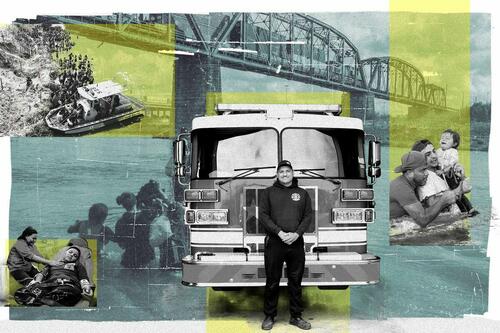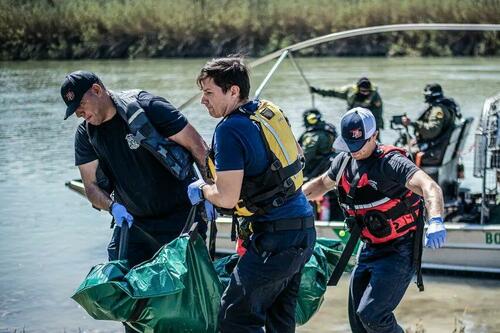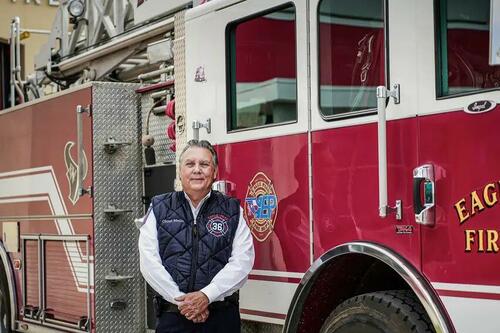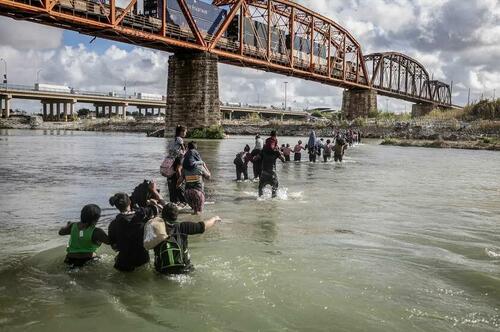The Hidden Cost Of The Border Crisis Nobody Tells You About
Authored by Janice Hisle via The Epoch Times (emphasis ours),
Mass illegal immigration is pushing rescue crews in this small Texas border town close to their breaking point.

The mighty Rio Grande has become a river of misery for Eagle Pass Fire Chief Manuel Mello III and his 52 first responders.
His medics sometimes confide: “Chief, I’m sick and tired of going out to the river and pulling bodies out,” Chief Mello told The Epoch Times, as he described how much the border crisis is affecting his department’s rescue workers.
They are grappling with record numbers of drowned men, women, and children who perish while crossing the river from Mexico into the United States.
The chief’s crews are risking their lives in nightmarish scenarios with unidentified people who are sick, hurt, or dead—not just along the river, but also on nearby roads, ranches, and railways.
They are responding to immigration-related emergencies so frequently that legal residents of their own community may be left waiting for medical care.
“There are days it seems that the ambulance wails never stop,” the chief told a congressional committee recently, noting that many of those ambulances are headed toward the Rio Grande and its surrounding area.
People in the community hear those sirens. Some see the bodies washed up along the riverbank. And they feel the impact.
“It breaks my heart to know that there are children drowning in the river; there are people on the way over here being raped and being robbed,” Eagle Pass resident Ruben Camarillo, a 35-year-old father of a 9-year-old son, said.
As he stood on a city street corner in support of former President Donald Trump’s recent border-focused visit to Eagle Pass, Mr. Camarillo told The Epoch Times that illegal immigration is “causing so much death and destruction ... and we’re experiencing that firsthand.”
Rescuers Need Assistance
The Eagle Pass Fire Department is getting little, if any, help from the federal government to ease burdens stemming from the nation’s border crisis, Chief Mello said.
He’s seeking funds to cover costs from hundreds of ambulance runs carrying illegal aliens. He also is trying to secure counseling for first responders who are coping with stress and trauma that linger long after they go off duty.
While dealing with death is an accepted part of an emergency responder’s job, Eagle Pass medics are overdosing on gruesome encounters that are rare occurrences elsewhere—such as drowned children.
“The mental impact will take a long time to heal if we do not get help for them soon,” the chief told federal lawmakers.

Above all, Chief Mello would like to see U.S. leaders stem the tide of illegal immigrants. That would be much better than throwing money at the consequences, he said.
“There needs to be some unity within the federal government so we can actually stop it,” the chief said.
In hopes that the right people finally hear—and heed—his pleas, Chief Mello shared his story with Congress in brief testimony earlier this year. He also gave a two-hour interview to The Epoch Times about the challenges that his department faces.
But the chief also emphasized that the problems extend beyond Eagle Pass. “It’s not just me with this issue,” Chief Mello said. “It’s every single fire department along the border.”
‘Epicenter’ of Crisis
Still, Eagle Pass arguably has been affected more than the average border town.
“At points, we have had 1,500 people crossing [the Rio Grande] at one time,” Chief Mello said. One evening, 2,000 people were lined up, waiting to be transferred to a U.S. Border Patrol processing station; by the next morning, the line had grown to 4,000.
That influx fits into a larger picture. Since taking office in 2021, President Joe Biden has enacted more than 500 immigration policies, many of them reversing or rolling back measures enacted by his predecessor, President Trump.
Illegal border crossings during the Biden administration have surpassed the 9 million mark, mostly at the U.S.–Mexico border, according to Customs and Border Protection data.
Because of the recent surges, Eagle Pass has been in the national spotlight frequently.
Sometimes called “the epicenter of the border crisis,” the city has been the site of a standoff between state and federal government agencies. They are clashing over approaches to illegal immigration, just as the two leading presidential candidates do.

While President Trump advocates a crackdown on illegal immigration, President Biden has embraced a more “welcoming” approach and loosened restrictions.
But the crisis has escalated so much that “even some of Biden’s fellow Democrats have begun advocating for more stringent border control,” the Migration Policy Institute noted.
One Month, 17 Drownings
When Chief Mello first joined the fire department in 1992, the Rio Grande’s strong currents would snatch about six lives a year.
But the department recently recovered 17 victims drowned in a single month, the chief said, citing figures from Jan. 20 to Feb. 19.
That’s a record high during Chief Mello’s 32-year career, which includes a decade as chief. And it excludes drowning victims that the Border Patrol or other agencies picked up.
“These past couple of years, we have been going to the river, basically almost every day—sometimes three, four times a day—for drownings; for body recovery,” Chief Mello said.
The casualty count has fluctuated over the years, but before 2021, the annual number of drownings was a dozen or fewer.

However, according to Chief Mello, in 2023, his crews retrieved 43 bodies from the Rio Grande; the youngest was a 2-month-old infant.
“I’ve seen 5-year-olds, 10-year-olds, when they’re pulled out of the river, their lifeless bodies,” the chief said, his brow furrowing.
Those images are seared in his mind. “It’s something that never goes away,” he said.
Most first responders in his department are “young guys,” many of whom are fathers of children who are about the same ages as the drowning victims, Chief Mello said.
Picturing their own children as they attend to the deceased or imperiled youngsters, these tough men are sometimes reduced to tears. The chief, too, has wept. A mixture of sadness and anger spills out.
“You get sad because of what they’ve been through,” he said, “but you also go through the anger.”
That’s because, encouraged by some government leaders, the illegal immigrants keep coming despite the risks to them and their children.
Sometimes crews spot migrants preparing to cross the river and shout warnings from the riverbank. “You’re telling them, ‘Go back, go back,’ because we know that it’s dangerous,” Chief Mello said. “But then you see them tying their children down.”
Shaking his head at the thought, the chief said he has seen adults strap children onto them, using ropes or rags, “and then they walk into the river.”
“Then you can see that little baby, going up and down, bobbing for air every time they go up and down,” he said. “And that’s very sad.”
For those who survive crossing the Rio Grande, “You see the mom and dad crying, because they’ve made that trek and now that they’re on U.S. soil,” the chief said.
Read more here...
https://ift.tt/8kGJ6Uw
from ZeroHedge News https://ift.tt/8kGJ6Uw
via IFTTT




0 comments
Post a Comment